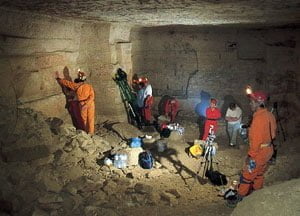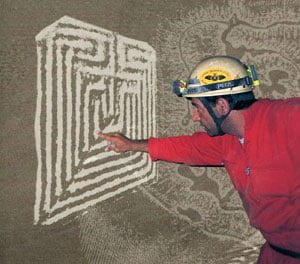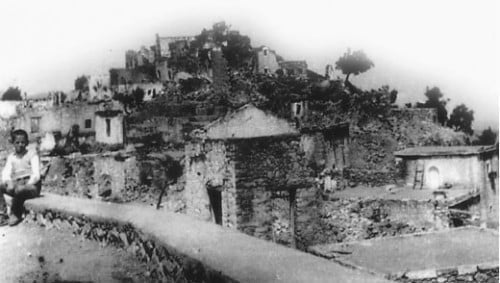Present and Future for the Labyrinth of Messara
Without a doubt, the Labyrinth, with its ideal location and its horizontal layers of the same rock, is an artificial quarry. The ideal thickness of the layers of pearly limestone, and the ease by which these layers come off, were the obvious criteria by which this area was chosen for the mining of building material. Even the most inexperienced eye can distinguish the scars of digging tools on the walls of the cave. For sure, thousands of people – the original miners – worked through the centuries in this confined, suffocating space, breathing dust and sweat from the stagnant air made even heavier by the heavy lingering fumes of the oil lamps.
The original creators of the Labyrinth did not set out to construct an impressively large and intricate cave for some specific purpose. They simply wanted to mine the valuable limestone – the perfect building material for home-construction in early, and even later, civilizations. In what was an unimportant marking on ancient maps, the original quarry somehow transformed over the years into a sacred lace. Thusly, the Labyrinth is quite possibly one of the very few cases where an area chosen as a work site eventually becomes the object of universal admiration – a tourist attraction of the highest magnitude.
Today, the old Labyrinth faces serious structural problems. Most of the support columns have been collapsing under the enormous weight of overlaying rocks and stones. Huge limestone slabs, tens of square meters in area and weighing many tons, have broken off from the ceiling – some have come crashing to the floor, while others still hang dangerously from above. The explosions caused by the German occupiers have totally destroyed a section of the cave, and have dramatically worsened the structural problems throughout the entire area between the two entrances.

Each year since 1999, when the Cretan Department of the Hellenic Speleological Society began its systematical study of the cave, many stone sections from ceilings and walls have collapsed. And, no doubt, the natural destruction will continue and more and more sections will have to be closed. Eventually, the total collapse of the Labyrinth may become a reality, and all those valuable links to past civilizations will be lost forever. But, will the end of the Labyrinth really be the result of natural causes, or will it come about due to the ignorance and indifference of those concerned – especially those in positions of power?
The initiative and effort of the dedicated speleologists from the Hellenic society to establish the cultural and social value of the Labyrinth, as well as its on-going problems, are aimed at touching the public’s sensitivities on the subject. The same is true with the informative stories which have been written in the special publication distributed by the municipality of Mires . We want to believe that with the publication of all these informative facts, as well as with others that are sure to follow, we will don the cloak of responsibility for all things lost, and take on the role of protectors of the past. We must categorize and prioritize these responsibilities, and, if we judge them to be of major importance – a lifeline to civilizations past – then we must act to save our heritage for our children, and our children’s children.
Antonis Vasilakis
Efforts for Restoring the Labyrinth of Messara
The Labyrinth with all its corridors and passages of more than 3.5 kilometers could again become a major attraction pole for millions of tourists. The municipalities in the surrounding area have understood this fact and have been trying for years to recover and restore this historical monument in the Mesara area. Unfortunately, the Greek government has not shown any appropriate interest in the project. Some of those in power have expressed a view that the Germans, who destroyed it during their departure from Crete at the end of World War II, should be responsible for its restoration. During the occupation of the island, the German army used the Labyrinth to warehouse arms, then dynamited this monument of Cosmic History as they retreated, so that the allied forces could not use the armament. This move, they say, would be a show of civility and respect for the history of a country which they wounded irreparably.
For this reason, a few months ago the German Consul in Iraklio, and the Military Attaché of the German Embassy in Athens, visited the Labyrinth. The German officers’ interest in having the German state contribute towards the restoration was stated to the media at the time. Many believed that something could be done to have the Labyrinth reinstated as a monument of universal interest. Also, its rehabilitation would provide an important site for every Greek, foreign historian and history expert. Unfortunately, the Greek state, through its General Army Staff, is simply not interested. On the other hand, the Germans go just so far – without committing anything. They are not willing to spend a penny for the Labyrinth’s restoration. They didn’t give a penny anyway, when, during their departure, they placed the dynamite and blew up this cosmic social and cultural inheritance.
In his letter to Panayiotis Sfakianakis, Mayor of Mires, the German Military Attaché, Squadron Commander Claus-Peter Hornbogen, states that after the refusal of the Greek General Army Staff to allow German soldiers, together with Greeks, to proceed in the removal of the munitions, the action stops here, as Germany is not willing to underwrite any of the economic cost for the Labyrinth’s restoration.
According to the letter from the General Army Staff: “any work in the cave’s interior continues to present dangers to the security of personnel caused by the static insufficiency in that its interior walls are unstable and the scattered missiles don’t allow work to reinforce its inner walls. It was also asked by the municipalities of the area to seal the entrances, at their cost, to avoid any further accidents.”
(Note: The above mentioned copy is from the local newspaper Antilalos tis Messaras, dated June 14, 2005 )
The Labyrinth, Epilogue

What can anyone say about this unbelievable story? For thousands of years the Messara Labyrinth in southern Crete welcomed its guests, who left their signatures in its loins. It offered refuge to the Cretans when persecuted by barbarian conquerors. Its dark daedalean corridors and chambers gave food to the imagination, and the Cretans’ fertile imagination bore myths and fairytales to the horror of children and the amusement of grownups.
For thousands of years the Minotaur had made the Labyrinth its home – of course he didn’t frighten anyone anymore, since he was bested by the Greek hero Theseus. And, also for thousands of years, the Labyrinth bejeweled Crete as an important landmark, before being destroyed by barbarians who respected nothing – not human lives nor civilizations.
The Cretan people, with their magnanimous souls, can separate in their memories the Germans of the Nazi occupation force from the German tourists who visit our country today and are welcomed with open arms. However, the grievance remains: Once we had a famous and historic Labyrinth in Crete and it was a part of our identity. This part of us was taken, ripped from the soul of our birthplace, with the arrogance of a conqueror. Certainly, times have changed – but as long as some of us still know and choose to remember we will be asking for it back.
Yannis Samatas
NOTE. This story comes from the book “The Labyrinth of Messara” by Kaloust Paragamian and Antonis Vasilakis.
Read more:
- The Labyrinth of Messara in Crete
- Working in the Labyrinth for the German Army in 1943
- The Interpreter for the German Army in the Labyrinth of Messara
- Famous Visitors in the Labyrinth of Messara
- Inscriptions on the Walls of the Cave
- Present and Future for the Labyrinth of Messara
© explorecrete.com All Rights Reserved. Reproduction or copying without permission is prohibited.






